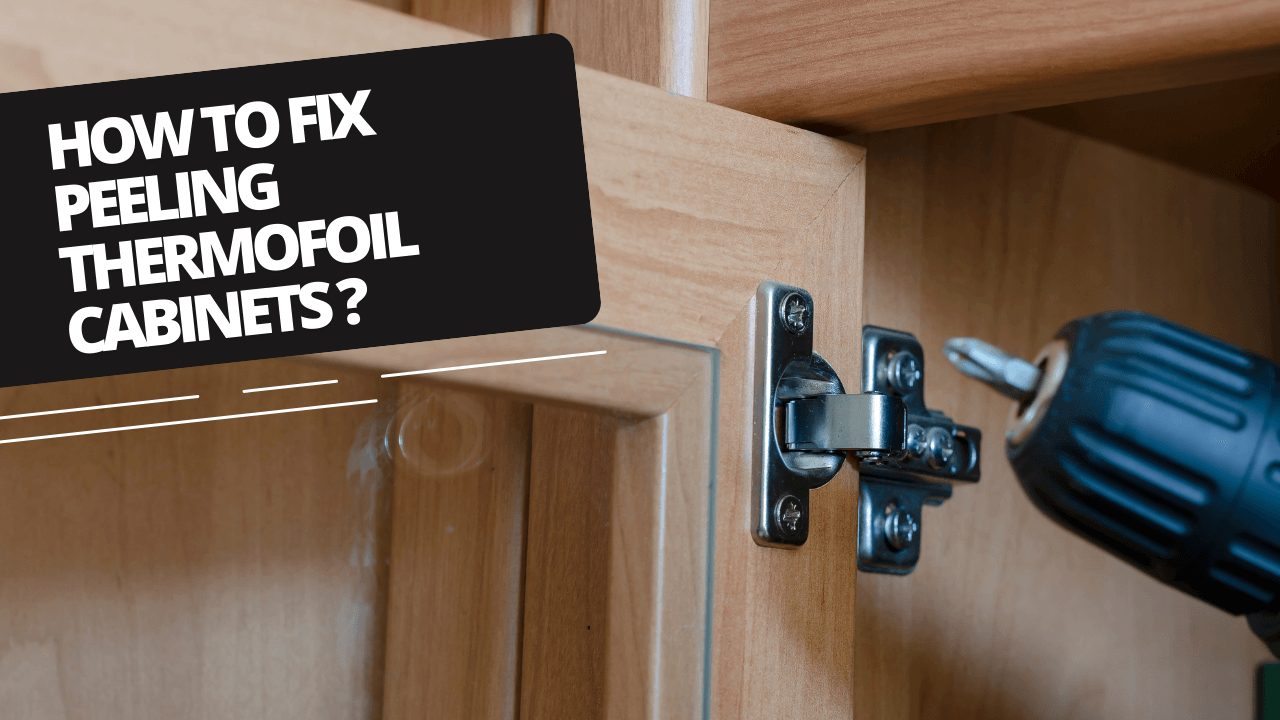A thermofoil-coated bathroom or kitchen cabinetry is a mixed blessing. The good news is that thermofoil cabinets are among the most affordable cabinets available. The thermofoil in cabinets, on the other hand, is susceptible to delamination of the medium density fiber foundation MDF.
You can remedy the thermal coating of the peel very fast by gluing it in place rather than live with the problem or going the more expensive path of buying new cabinets. So, if you want to extend the life of your thermofoil kitchen cabinets, here are some ideas and suggestions:
Thermofoil cabinets are typically made of medium-density fibreboard with a heat-treated vinyl shell on top. Over time, the shell may become brittle and separate from the MDF.
This can appear flaking on the cabinet corners or massive chunks breaking off when you touch the edges, revealing the MDF underneath. To fix the vinyl back to the MDF and repair your cabinets’ peeling and torn parts, use a moisture-resistant adhesive.
Table of Contents
The Reasons Of Thermofoil Cabinet’s Peeling
You incur the risk of delamination whenever you have a laminated or veneered material. After a few years, it’s usually for a wood veneer to start flaking off furniture. The process will be accelerated by traffic, touch, and humidity. Thermofoil cabinets, on the other hand, are particularly prone to delamination.
Unlike wood veneer over wooden furniture, the thermofoil consists of two different materials sandwiched together. Thermofoil is a thin vinyl material that is vacuum-applied on MDF panels and then heated.
The binding between thermofoil and MDF is strong once applied, but it can break down over time. The link between the thermofoil and the MDF may be loose by heat, dampness, or a combination of the two.
Humidity and direct touch with water will further exacerbate the delamination process in restrooms, which are high humidity environments.
When Do You Need To Replace The Thermofoil Instead Of Repairing?
You can proceed with the repair if it is a one-time fix that only affects one or two corners of the cabinet.
However, if this is a widespread issue in your kitchen, you might consider replacing all your cabinets or adding new doors. It’s advisable to get new cabinet doors or reface them if the cabinet boxes are good, but the cabinet doors are crumbling.
You should not attempt to fix your base MDF if it bugles or is not flat and smooth. MDF boards that are warped cannot be sanded, planed, or smoothed. So, it’s up to you to either repair the thermofoil or replace it with the new one.
Steps To Fix Peeling Thermofoil Cabinets
You may notice that the thermofoil on your kitchen cabinets or other furniture is starting to peel slightly after years of wear and tear in your home. Without the hefty cost of replacing the furniture, you may fix the peeling yourself at home.
Thermofoil is similar to any other type of laminate or veneer over MDF or wood, except that it is attached to the MDF substructure using a heat process rather than glue during manufacturing. Your thermofoil furniture will look brand new if you treat it like laminate and use the same glue that furniture manufacturers do.
1) Peel Away The Old Thermofoil From The Cabinet
Hold the peeling thermofoil away from the MDF with the help of a friend. Pulling too hard or at an extreme angle may cause the old thermofoil to snap or split. Scrape any excess cement from prior repairs with the thermofoil pulled back.
Carefully lift the peeling edge. Sand any residual adhesive off the MDF using the corner of a piece of sandpaper. It’s possible to have lines and bumps under the vinyl layer if you glue over old, hard adhesive.
2) Use Contact Cement For Back Coating
Coat the back of the thermofoil and the top of the MDF with contact cement while the assistant keeps the thermofoil away from the MDF. Apply contact cement to the margins of the project. Do not return the foil to its original place right away. The cement’s directions tell you how long to wait before pressing the two ingredients together.
Using a little artist’s paintbrush, apply glue to the MDF under the peeling vinyl edge. Contact cement or another water-resistant adhesive are all excellent options. Apply a tiny amount on the bottom of the peeling vinyl and wait for the glue to get tacky, about a minute.
3) Apply Flexible Protective Material
Combine the two materials by pressing them together. For about an hour, keep it firmly in place. Sandwich the work between two pieces of flat scrap wood, held in place with a carpenter’s clamp, using the flexible materials as protection on the face of the thermofoil. Remove the excess cement carefully away from the edges with your fingers or a piece of cloth.
Using a dry rag, wipe away any excess glue, then use painter’s tape to secure the glued section. Remove the tape after about two hours to allow the adhesive to dry. With a pointed chisel, chip away any excess glue that has squished to the surface, taking care not to damage the vinyl thermofoil cabinet covering.
Final Words
Repairing, refacing, repainting, and staining your kitchen cabinets if they are still in good physical condition are some of the less expensive options to restore their attractiveness. If the thermofoil isn’t peeling, you can paint over it. Request the appropriate primer from your local paint store, then apply the desired finish paint.
For sure, this post will help you to repair or replace the thermofoil cabinets efficiently. If you are still looking for guidelines, you can also ask your local contractors for further assistance.





